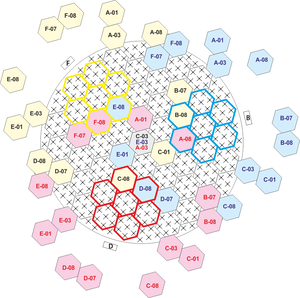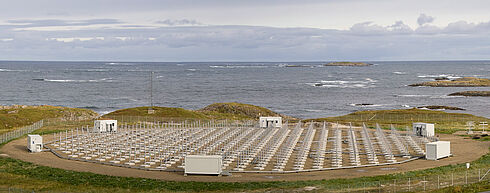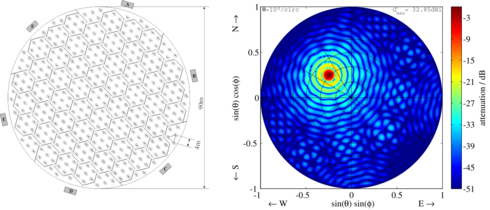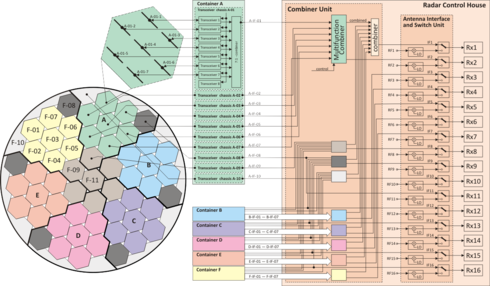MAARSY is a monostatic radar system operated at 53.5 MHz with an active phased array antenna consisting of 433 Yagi antennas. The 3-element Yagi antennas are arranged in an equilateral triangle grid forming a circular aperture of approximately 6300m2. Each individual antenna is connected to its own transceiver with independent phase control and a scalable output up to 2 kW. This arrangement allows very high flexibility of beam forming and beam steering with a symmetric radar beam of a minimum half power beam width of 3.6°, a maximum directive gain of 33.5 dBi and a total transmitted peak power of approximately 800 kW.
The antenna array is divided into 61 subgroups, 55 of the groups are hexagons and consist of 7 antennas each, 6 subgroups contain 8 antennas each and are located at the perimeter of the antenna array, which makes the overall field approximate a circular shape. The beam width of the radiation pattern of a single hexagon structure is about 30°, that of a combination of 7 adjacent hexagonal subgroups (anemone structure) is about 11°.
The 433 Yagi antennas developed and built at the IAP are connected to 433 transceiver modules, which are located in 6 containers at the perimeter of the field. Frequency, phase and output power of the transceivers are adjustable and are continuously monitored. The transmission and reception technology of the radar was manufactured by the Australian company Genesis Software Pty Ltd.
The IF signals of each 7 transceivers connected to each 7 antennas arranged in a hexagon are combined to 61 receiving channels. Selected channels or combinations of IF signals are sent to a 16-channel data acquisition system with 25 m sampling resolution and 16-bit digitization specified. The high flexibility of MAARSY allows classical Doppler beam swinging as well as experiments with various beam widths and the use of modern interferometric applications e.g. the use of imaging techniques to study mesospheric structures (Sommer et al., 2016) or the positioning of meteor head echoes (Schult et al., 2015).
The pulse functionality of the radar allows the quasi simultaneous transmission of signals of different lengths. This makes it possible to transmit a short pulse for layers with a typically high backscatter coefficient such as the lower troposphere, and a long, coded pulse with a higher average power for the upper troposphere and lower stratosphere, which have a lower backscatter coefficient, as well as the mesosphere. In standard operation, measurements are therefore performed simultaneously in the mesosphere, stratosphere and troposphere, from 1.5 km altitude with 150 m resolution and from 6 km altitude with 300 m resolution.

In 2018, the MIMO method was integrated into the regular MAARSY radar control system. A firmware upgrade now enables transmissions in independent sections of the entire antenna field. In combination with the existing 15 receive channels, which are connected to individual antenna subgroups (hexagons), a larger, virtual antenna aperture is created. In combination with imaging techniques (Urco et al., 2019), mesospheric structures can now be detected with a previously unattained angular resolution of about 0.6°.
More related information
- R. Latteck, W. Singer, M. Rapp, B. Vandepeer, T. Renkwitz, M. Zecha und G. Stober, MAARSY - the new MST radar on Andøya-system description and first results, Radio Sci., doi:10.1029/2011RS004775, 2012.
- T. Renkwitz, G. Stober, R. Latteck, W. Singer und M. Rapp, New experiments to validate the radiation pattern of the Middle Atmosphere Alomar Radar System (MAARSY), Adv. Radio Sci., 11, 283-289, doi:10.5194/ars-11-283-2013, 2013
















